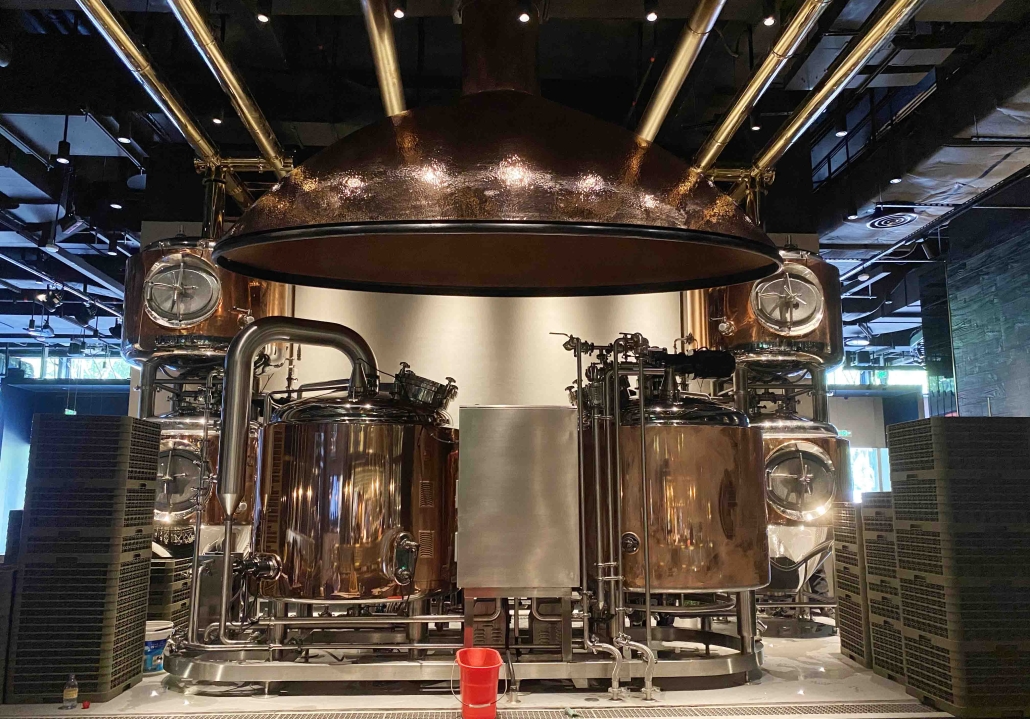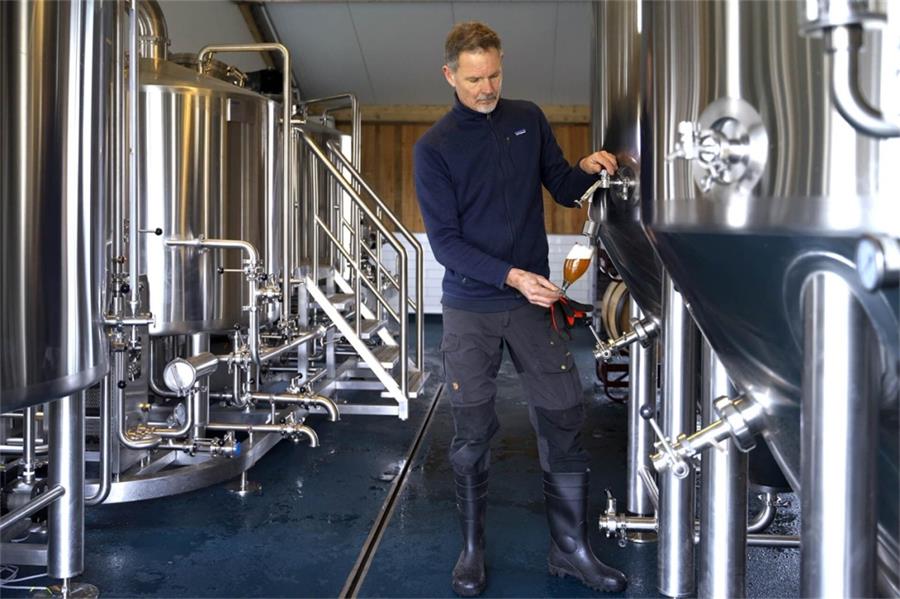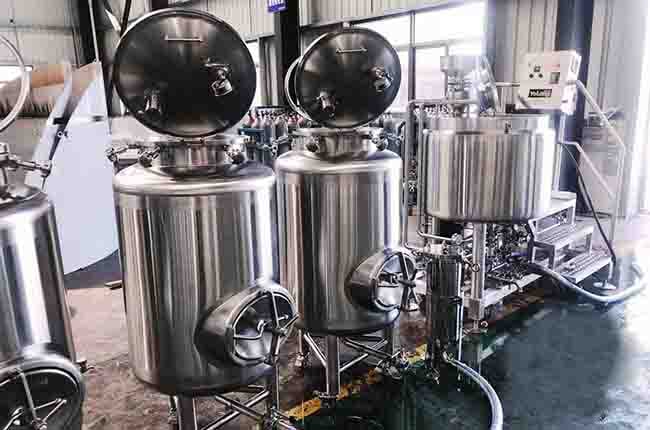1 BBL Brite Tank
A 1 BBL (Barrel) brite tank is a critical piece of brewing equipment used for storage and clarification of beer after fermentation. This guide provides a comprehensive overview of 1 BBL brite tanks including types, design considerations, sizing, installation, suppliers, prices, and FAQs.
Overview of 1 BBL Brite Tank
Brite tanks, also known as bright beer tanks or serving tanks, are stainless steel vessels used for storing, clarifying, carbonating, and serving beer. They are an essential component of any microbrewery or taproom looking to craft and serve high volumes of fresh beer.
This guide focuses specifically on 1 barrel (BBL) brite tanks, which can hold 31 gallons or approximately 124 liters of beer. Key details include:
- Role in brewing process – clarify, store, carbonate, serve beer
- Typical capacity – 1 BBL (barrel), equal to 31 gallons or 124 liters
- Construction – stainless steel
- Shape – cylindrical with conical bottom
- Features – cooling jackets, clean-in-place (CIP) spray balls, racking arm, sight glass, pressure rating
- Used by – microbreweries, taprooms, taphouses
Continue reading for a full breakdown of 1BBL brite tank selections, specifications, installation considerations, operational procedures, maintenance, and FAQs. Whether you are looking to upgrade your existing small batch brewing system or building a brewpub from the ground up, this guide will equip you to make informed equipment decisions.

Types of 1 BBL Brite Tanks
There are a few key varieties of 1 BBL brite tanks to consider:
Table 1: Types of 1 BBL Brite Tanks
| Type | Description |
|---|---|
| Cylindrical | Traditional cylindrical shape with flat or sloped bottom |
| Conical | Cylindrical top with angled/conical bottom ending in valve |
| Stacked | Two or more cylinders stacked vertically |
| Mobile | Mounted on casters for portability |
| Direct draw | Built-in faucets for direct serving |
The choice depends largely on the available space and serving style of your brewery:
- Conical bottom tanks allow more compact sediment collection but take up more vertical space.
- Stacked tanks maximize storage capacity if you have the headroom.
- Mobile brite tanks provide flexibility for small spaces.
- Direct draw tanks enable pour-a-draft functionality.
Many manufacturers offer modular, customizable 1 BBL brite tanks so you can tailor them to your needs in terms of shape, height, width, accessories, and functionality.
1 BBL Brite Tank Design Considerations
Properly designing your brite tank system requires some upfront planning. Key factors to consider include:
Table 2: 1 BBL Brite Tank Design Factors
| Consideration | Details |
|---|---|
| Volume | Standard 1 BBL = 31 gallons, but confirm capacity |
| Dimensions | Measure space constraints – height, width limitations |
| Shape | Cylindrical, conical bottom, stacked, mobile |
| Construction | Stainless steel grade and finish |
| Cooling method | Glycol, refrigeration, jackets |
| Accessories | Site glass, sample valve, racking arm, CIP, casters |
| Customization | Modular tanks allow customization |
| Serving style | Direct draw faucets or remote taps |
| Budget | Balance performance and cost |
Thinking through these elements upfront ensures your tanks properly integrate into your overall brewery design and workflow. Work closely with equipment suppliers to spec a tank customized for your needs and constraints.
Typical 1 BBL Brite Tank Specifications
While 1 BBL brite tanks vary across manufacturers, some typical specifications include:
Table 3: Key 1 BBL Brite Tank Specifications
| Parameter | Details |
|---|---|
| Volume | 31 gallons or 1 barrel (BBL) |
| Height | 48-84 inches for single cylinder |
| Diameter | 24-36 inches |
| Thickness | Up to 1/4 inch for cylinder |
| Material | 304 or 316 stainless steel |
| Finish | Interior polish, exterior brushed or mirror |
| Pressure rating | 60-120 psi design pressure |
| Cooling method | Glycol, refrigeration, cooling jackets |
| Valves | Sample valve, racking arm, bottom dump valve |
| Nozzles | CIP sprayball, carb stone, PRV, sight glass |
| Agitator | Top or bottom mounted |
| Weight | 130-500 lb empty depending on construction |
Again, modular brite tank systems allow customization of most parameters including capacity, dimensions, features, and accessories. Work with an experienced fabricator to spec tanks matching your operational requirements.
1 BBL Brite Tank Sizing
Properly sizing your brite tank system is critical – too big wastes money and space, too small limits production. Use the following best practices:
- Determine beer production volumes – 1 BBL holds 31 gallons. Estimate your annual or monthly volumes. Allow room for growth.
- Calculate total tank volume needed – Multiply production volume by average beer age (residence time) to determine holding capacity needed. Example: 5 BBL/week production x 3 week average age = 15 BBL total capacity needed.
- Choose number and size of tanks – Given space constraints, select appropriate number and size of 1 BBL tanks. Example: With 450 BBL annual production, install six 1 BBL brite tanks allowing 2 month beer storage capacity.
- Consider peak usage – Account for periods like holidays that drive higher production volumes. Add overflow capacity.
- Leave room to grow – Adding tanks down the road is easier if you design in space for expansion.
Consult an experienced brewery equipment supplier to right-size your tank farm capacity. They can spec an modular, scalable brite tank system meeting current and future brewery needs.
1 BBL Brite Tank Suppliers and Pricing
Many commercial brewing equipment manufacturers offer 1 BBL brite tanks with prices varying based on features and customization. Expect to invest $2,000 to $10,000+ per tank.
Table 4: 1 BBL Brite Tank Manufacturers and Price Ranges
| Supplier | Description | Price Range |
|---|---|---|
| JV Northwest | Stainless steel tanks, made in USA | $3,000-$8,000 |
| Ss Brewtech | Modular glycol, refrigerated or direct draw | $4,000-$9,500 |
| Premier Stainless | Custom fabricated brew systems | $5,000-$15,000 |
| Specific Mechanical | Jacketed conical and cylindrical | $3,500-$8,000 |
| Psycho Brew | Custom direct draw brite tanks | $6,000-$12,000 |
| AAA Metal Fabrication | Custom brewery equipment | Get Quote |
Pricing for each 1 BBL brite tank varies based on:
- Dimensions and capacity
- Materials and construction
- Features and accessories
- Conical vs cylindrical design
- Cooling and insulation
- Freight, delivery, installation costs
To find the best value equipment matching your exact brewery specifications, get quotes from multiple vendors. Focus both on upfront capital costs and ongoing operation/maintenance expenses over the equipment lifetime.
Installing 1 BBL Brite Tank
Properly installing brite tank systems ensures safe, efficient ongoing operations. Work with equipment suppliers and contractors to:
Table 5: 1 BBL Brite Tank Installation
| Task | Details |
|---|---|
| Site preparation | Level concrete floor, layout, prep connections |
| Rigging | Coordinate crane/rigging to place tanks without damage |
| Mounting | Bolt down cylinders, anchor conical base |
| Connect cooling | Install glycol/refrigeration lines & sensors |
| Plumb tanks | Connect CO2, beer, water, drain lines |
| Add hardware | Install valves, racks, ladders, guard rails |
| Test | Pressure test for leaks, verify connections |
| Clean & passivate | Remove construction dust, passivate internals |
Installing multiple stacked brite tanks or those integrated into a brew deck may require structural modifications. Work with structural engineers ensure floor and designs meet seismic, load distribution, and building code requirements.
Operating 1 BBL Brite Tank
Once installed, properly operating your brite beer tanks improves quality and consistency:
Table 6: 1 BBL Brite Tank Operation Guide
| Phase | Procedure |
|---|---|
| Fill | Pump cooled beer via racking arm to bottom of tank |
| Chill | Set glycol/refrigeration to 34-38°F, allow beer to clarity and chill – 1-3 weeks |
| Carbonate | Use carb stone to add CO2, carbonating to 2.5-3 volumes |
| Store | Hold bright beer chilled until serving |
| Serve | Connect beer and gas lines to faucet/taps |
Key operation tips:
- Minimize oxygen exposure
- Maintain chill temperature
- Adjust carbonation levels
- Allow particles to settle
- Check clarity through sight glass
- Ensure proper line balancing to faucets
Follow detailed standard operating procedures from your equipment manuals for each operational phase. Maintain records for process consistency batch to batch.
Maintaining 1 BBL Brite Tank
Proper cleaning and preventative maintenance ensures maximum 1 BBL brite tank efficiency and lifespan. Key tasks include:
Table 7: 1 BBL Brite Tank Maintenance
| Task | Frequency | Details |
|---|---|---|
| Inspect sight glass & sample | Daily | Check for clarity issues |
| Clean brite tank | After each batch | Hot caustic soak, pressure wash to remove organic deposits |
| Inspect mechanicals | Monthly | Check/tighten fasteners, supports, gaskets |
| Lubricate valves | Monthly | Use food grade grease on o-rings, seals |
| CIP spray balls | Quarterly | Verify spinning freely, no clogs |
| Inspect glycol lines | Annually | Pressure test lines for wear/leaks |
| Passivate tanks | Annually | Citric acid wash removes scaling, maintains finish |
| Verify pressure rating | Every 5 years | Confirm system rating PSI |
Keep maintenance logs detailing tank performance over time. Watch for trends indicating potential problems – inconsistent beer clarity, chilling times, or quality could signify maintenance issues. Schedule annual preventative maintenance and tank passivation during brewery slow seasons.

FAQs
| Question | Answer |
|---|---|
| Do I need a brite tank? | Brite tanks help clarify, store, carbonate, and serve finished beer. They allow extended aging without losing taps to fermenters. |
| What size brite tank should I get? | 1 BBL tanks hold 31 gallons, suitable for many microbreweries and taprooms. Right size your system based on production volumes and serving needs. |
| How are brite tanks cooled? | Glycol, refrigeration lines, cooling jackets, etc maintain serving temperature of 34-38°F. |
| What are the parts of a brite tank? | Key components include sight glass, racking arm, dump valve, sample port, caster wheels, cleaning ports, carb stones, and cooling lines. |
| Can you stack brite tanks? | Yes, some systems allow vertically stacking tanks to multiply capacity without expanding footprint. Requires sufficient structural support. |
| Where should brite tanks go in a brewery? | Locate brite tanks close to the taproom/serving area for easy access. they require floor drains for cleaning. |
| How much do 1 BBL brite tanks cost? | $2,000 – $10,000+ per tank depending on size, material, features. Get quotes from multiple vendors. |
| Can I rent brite tanks? | Some beverage equipment companies offer brite tank rental options at monthly rates rather than purchasing. Useful for pilot systems or peak seasons. |
Additional FAQs for a 1 BBL Brite Tank
1) What pressure rating is appropriate for a 1 BBL Brite Tank used for carbonation?
- Look for MAWP of 2–3 bar (30–45 psi). This safely supports force-carbonation to 2.4–2.8 vols CO2 and maintains head pressure for service. Verify PRV setpoint, vacuum relief, and documentation (ASME/PED where required).
2) How much glycol chiller capacity do I need for one or two 1 BBL brites?
- Rough rule: 0.2–0.3 refrigeration tons per 1 bbl brite holding at 34–38°F; add headroom for fast crash or multiple tanks. Two brites typically need about 0.5–0.8 tons combined.
3) What fittings and instrumentation deliver the best value at this size?
- Carb stone with sintered diffuser, sample valve, rotating racking arm with position marks, pressure gauge + PRV/vacuum combo, sight glass, dedicated CIP spray device sized to your pump, and a thermowell/RTD tied to glycol control.
4) How do I minimize oxygen pickup during transfer into a 1 BBL brite?
- CO2 purge the brite and lines, displace with CO2 until >3 vessel volumes, maintain positive head pressure (5–10 psi), use fully closed transfer with CO2‑purged hoses, and avoid splashing. Target packaged DO <100 ppb (≤50 ppb for hop‑forward beers).
5) Can a 1 BBL Brite Tank be used for direct draw in a taproom?
- Yes. Ensure food‑grade lines, proper restriction/balance, 34–38°F setpoint, adequate PRV, and regular CIP. For mobile/direct‑draw brites, use locking casters and secure gas bottles; confirm local code for serving from tanks.
2025 Industry Trends: 1 BBL Brite Tank
- Low‑oxygen handling standardization: Even small brite tanks now spec O2‑tight gaskets and closed-transfer ports; more operators log DO pre‑pack.
- Energy/water efficiency: Thicker insulation and tighter glycol control reduce cycling; optimized CIP recipes cut chem/water use by 10–20%.
- Compact cellars: Mobile and stacked 1 bbl brites help nano taprooms expand SKUs without expanding footprint.
- Smarter QA: Affordable inline DO and handheld CO2/pressure tools improve carbonation accuracy and shelf life.
- Supply normalization: Lead times for standard 1 bbl brites improved vs. 2022–2023; custom direct‑draw/manifold options still add weeks.
2025 Benchmarks and Specs for 1 BBL Brite Tanks
| Attribute | Typical 2025 Value | Notes |
|---|---|---|
| Working volume | 1 bbl (31 gal / 124 L) | Verify total vs working headspace |
| MAWP | 2–3 bar (30–45 psi) | PRV set 1.0–2.5 bar typical |
| Interior finish (Ra) | ≤0.8 μm standard; ≤0.6 μm premium | Electropolish optional |
| Jacket zones | 1 (shell) at this size | Cone jacket optional |
| Insulation | PU foam, 30–50 mm | Reduces glycol cycling |
| New brite price | $3,000–$9,500 | Spec/finish dependent |
| Lead time | 4–10 weeks (standard) | Custom +2–6 weeks |
| Packaged DO target | <100 ppb (≤50 ppb for hazy IPA) | Requires closed transfers |
| Water:beer ratio (CIP) | 1.5–3:1 per turn | With optimized CIP program |
Sources: Brewers Association QA/benchmarking 2024–2025; MBAA Technical Quarterly; ASBC methods; EHEDG guidance; vendor spec sheets; ProBrewer practitioner reports
Latest Research Cases
Case Study 1: Closed Transfers Improve Stability from 1 BBL Brite to Tap (2025)
Background: A nano taproom saw aroma fade and occasional oxidation notes by day 45.
Solution: Implemented CO2‑purged, fully closed FV→brite→tapline transfers; upgraded to O2‑tight gaskets and added handheld DO checks pre‑service.
Results: Packaged/serving DO dropped from 140–220 ppb to 35–80 ppb; sensory shelf life extended beyond 90 days in cold chain; pour consistency improved, foam stability complaints down 30%.
Case Study 2: CIP Optimization Cuts Utilities for 1 BBL Brites (2024)
Background: High water and chemical use on frequent small‑batch turns.
Solution: Standardized CIP with conductivity‑based phase termination, verified spray coverage, and adopted lower‑temp extended caustic where appropriate.
Results: CIP water/chemical consumption reduced 18%; tank turn time decreased by 12 minutes; no micro positives over 4 months of monitoring.
Expert Opinions
- Dr. Tom Shellhammer, Professor of Fermentation Science, Oregon State University
“Even on 1 bbl brites, controlling oxygen ingress and carbonation precision has an outsized impact on flavor stability and consumer perception.” - John Mallet, Brewing Operations Consultant; author of Malt: A Practical Guide
“Specify the brite for your process—pressure rating, fittings, and cleanability drive day‑to‑day efficiency as much as tank size.” - Laura Ulrich, Senior Brewer and Pink Boots Society leader
“Make small tanks easy to clean and safe to use. Validated CIP, reachable ports, and tidy hose management keep quality high in tight spaces.”
Practical Tools and Resources
- Brewers Association – Small brewery QA, draft quality, sustainability: https://www.brewersassociation.org
- Master Brewers Association of the Americas (MBAA) – Technical resources on brite tank design/CIP: https://www.mbaa.com
- ASBC Methods of Analysis – DO, CO2, microbiology, clarity: https://www.asbcnet.org
- EHEDG – Hygienic equipment design guidance: https://www.ehedg.org
- ProBrewer – 1 bbl equipment threads, calculators, classifieds: https://www.probrewer.com
- Zahm & Nagel – QA instruments for CO2/air and DO: https://zahmnagel.com
Sources and further reading:
- Brewers Association 2024–2025 QA/benchmarking and draft quality resources
- MBAA Technical Quarterly on oxygen management, carbonation control, and CIP validation
- ASBC methods relevant to packaging DO and CO2 verification
- EHEDG hygienic design guidelines for vessels/fittings
- Vendor specifications for 1 bbl brite tanks and mobile/direct‑draw configurations
- Practitioner insights from ProBrewer on costs, lead times, and stacking/mobile safety
Last updated: 2025-09-08
Changelog: Added 5 targeted FAQs; inserted 2025 benchmarks/specs table; provided two 1 bbl case studies; included expert viewpoints; compiled practical tools/resources with authoritative links.
Next review date & triggers: 2026-01-15 or earlier if BA/MBAA/ASBC/EHEDG guidance updates, pricing/lead times shift, or new low‑oxygen/CIP standards impact 1 bbl brite specifications.
Share this entry
Interested in learning more about Brewing Systems including additional details and pricing information? Please use the form below to contact us!
YOLONG BREWERY EQUIPMENT FAQS
- Commercial Brewery / Craft Brewery / Microbrewery / Nanobrewery
- What is The Difference Between Craft Beer and Industrial Beer?
- The Bespoke Differences In Custom Brewing Systems
- Everything You Need to Know About Kettle Souring
- How to Choose Brewing Equipment for Your business?
- How To Choose The-Best Partner To Build Your Commercial Microbrewing System?
- Two Detection Sensors That You Need To Use In Your Brewhouse System
- Remote Control Applications in Brewing Equipment/How does it work?
- How To Clean Your Brand New Brewery Tanks?

